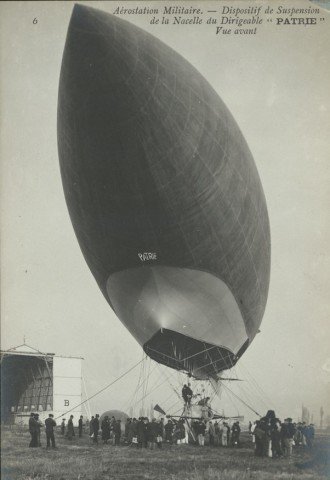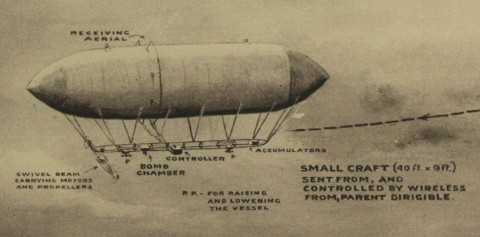The Lebaudy-built Patrie, seen above, was France’s first military airship. A descendent of the Jaune, in 1906 and 1907 it carried out a number of successful proving and publicity flights, including one where it carried the prime minister, Georges Clemenceau, over Paris. Afterwards it was moved to its operational base near the fortress of Verdun. Due to a mechanical failure during a subsequent flight it had to ground in the open, far from the safety of its hangar. A gale blew up, and even one hundred and eighty soldiers were unable to hold the stricken airship down. At 8pm on 30 November 1907, the Patrie floated off into the distance, fortunately sans crew.
That was not the last of the Patrie, however. It was feared that it would drift eastwards into Germany, giving the (likely) enemy a good look at the latest French aeronautical technology. Luckily the breeze took it northwest towards Britain, France’s partner in the Entente Cordiale. The Daily Mail reported that the Patrie was seen the following morning over Wales about 450 miles away, at Cardigan and at Llanelly in Carmarthen.1 That afternoon, the S.S. Olivine and the S.S. Captain saw the airship over the Irish sea, and then it was spotted at Larne and at Whitehouse, both near Belfast in northern Ireland.2 The airship actually dragged along the ground at one point, ploughing a furrow in a field at Ballysallagh, tearing a hole in a dyke, and leaving behind a number of mechanical artefacts.3 The War Office put a propeller under guard, presumably handing it back to its ally in due course.4 Then a report came in from the Lloyd’s signalling station at Torr Head, the extreme north-east of Ireland, to say that ‘a yellow dirigible balloon’ had passed overhead at 4.05pm, ‘going backwards’.5 About an hour later, Patrie was near Islay in the Western Isles, where it was seen by the steam trawler Lark heading north-northwest.6 After that there were no more reports, and we may presume that it eventually crashed and sank somewhere in the North Atlantic. Following so hard on the heels of the wreck in October of the British military airship Nulli Secundus, also in a gale (again, fortunately without casualties), some parts of the press discussed the need for ‘an organization of aerial ship “docks” and stations for emergency purposes’.7 According to the Cornishman, the Royal Engineers’ Balloon School had already prepared a map marking ‘specially-chosen hollows in woods, at the foot of sheltering hill-sides, and in deep gravel-pits, where an airship may descend in case of an emergency and lie sheltered even though a gale of wind be blowing above’.8
Now this is interesting to me as a very close analogue of a mystery aircraft panic, for example the false sightings of the Andree expedition balloon in Canada in 1896 and 1897. Here, though, it appears that the reports that the Patrie was floating over Wales and Ireland were real, as they follow each other in a fairly logical progression in time and space, tracing an arc from Verdun northwest to the sea beyond Ireland. They can indeed be plotted on a map, as above (though it is missing the Llanelli and the Captain sightings, and point 6 is wrong; though the Olivine‘s was almost the last sighting to be published it actually took place at 2pm on 1 December, that is between the sightings in Wales and the ones in Ireland, which makes sense because it took place at ‘lat. 53.48N, long. 5.27W — i.e. fully half-way between Holyhead and Dundalk, on the Irish coast’, so between points 2 and 3 and not at 58° N as on this map).9 This episode shows that ordinary people can accurately report what they see when confronted with something unexpected in the sky, which is something worth bearing in mind given all the episodes of mass aerial misperception I’ve discussed here in the past. When somebody says they saw an airship where it shouldn’t be, they aren’t always wrong.
And yet. Not all of the reports were accurate. Here is the Daily Mail‘s report from Cardiff:
The few residents of Carmarthen who were astir at eight o’clock this morning witnessed the flight of an airship over the district. All agree that the cigar-shaped craft was flying at a great speed at a very great height. According to one report the county police, with the aid of marine glasses, were able to distinguish three or four occupants in the cage.
Another rumour afloat is that when the airship was over Carmarthen a carrier pigeon was released, but at such a height that it became a mere speck, and the direction in which it flew could not be seen.
Some observers claim to have seen the name La Patrie through a telescope. The airship took a very erratic course, now so low as to look almost as big as a house, and anon rising to great heights, resembling a large cigar speeding rapidly through the air. The mystery is deepened by the fact that a second airship or balloon is alleged to have been seen about the vicinity.10
So. 1. Nobody was aboard the Patrie. 2. If nobody was aboard then there was nobody to release any pigeons (though perhaps some object broke loose and fell away). 3. While it can be seen in the photograph at the top of the post that ‘Patrie’ (not ‘La Patrie’) was inscribed on the envelope, the letters appear to be only a couple of feet high and it scarcely seems credible that they could be read even with a telescope. 4. Needless to say, there was only one airship!11
In addition, there was another sighting of the Patrie which isn’t plotted on the Wikipedia map because it was entirely false. This was in Scotland on the banks of the Clyde. Lord Blythswood, an amateur scientist with a laboratory at his estate at Erskine Ferry near Glasgow, was at this time experimenting with large box kites made of bamboo. He happened to choose the day the Patrie was adrift over the British Isles for a flight to investigate local air currents, lofting it to a height of 2000 feet where it hovered over Clydebank on the north side of the Clyde.12
Attention was at once directed to the object, and the greatest excitement prevailed, everyone jumping to the conclusion that La Patrie, the missing French airship, had drifted to Scotland. In the shipyards the platers neglected their chalk and line, the smiths their anvils, the engineers their callipers — all to stare at what they thought was the airship, which appeared to be traveling fast in a northerly direction.
No doubt was entertained of its identity, but as somehow it seemed to preserve a well-defined circuit and never to get beyond the horizon of easy vision, a newer excitement arose in the belief that it was collapsing and likely to fall at their feet. What fame for Clydebank! The Lusitania was forgotten. Alas! the usual sharp boy detected the string, and the excitement turned to laughter.
In Glasgow the afternoon papers gave a fresh vent to the excitement by announcing the arrival of the airship six miles away. The roofs of Glasgow’s tallest buildings were at once utilised and telescopes were levelled, but the strongest glass, owing to the haze, failed to discover anything. Instead of allaying interest these features rather intensified it, and when the late editions of the papers were compelled to explain away their own story there was quite as much chagrin as laughter.13
Setting the amused tone to one side, this account has several interesting features. 1. News that the Patrie was adrift had already reached Clydebank, presumably in the morning papers. 2. The witnesses quite confidently identified what was presumably a relatively small box kite with a much larger airship. 3. The afternoon newspapers spread the idea of an errant airship to Glasgow on the opposite bank. 4. Despite this priming, nothing was seen from Glasgow, whether airship or kite.
In the end the last flight of the Patrie, while providing a useful reminder that people didn’t (always) make their airships out of whole cloth, shows that even when a real airship was involved it was still very possible for them to add their wrinkles to the fabric.
Image source: 100 Years Ago Today.
![]() This work is licensed under a Creative Commons Attribution-NonCommercial-NoDerivatives 4.0 International License.
Permissions beyond the scope of this license may be available at http://airminded.org/copyright/.
This work is licensed under a Creative Commons Attribution-NonCommercial-NoDerivatives 4.0 International License.
Permissions beyond the scope of this license may be available at http://airminded.org/copyright/.
- Daily Mail, 2 December 1907, 7. [↩]
- Ibid., 2 December 1907, 7; ibid., 6 December 1907, 7; Western Times (Exeter), 7 December 1907, 4. [↩]
- Daily Mail, 5 December 1907, 7. [↩]
- Western Times (Exeter), 7 December 1907, 4. [↩]
- Daily Mail, 3 December 1907, 7. [↩]
- Ibid., 4 December 1907, 7. [↩]
- Citizen (Gloucester), 2 December 1907, 5. [↩]
- Cornishman (Penzance), 12 December 1907, 7. [↩]
- Daily Mail, 6 December 1907, 7. [↩]
- Ibid., 2 December 1907, 7. [↩]
- Though, just as with the Cardiff phantom airship sightings in 1909, it’s interesting to note that airship pioneer E. T. Willows was a local; but I think he was again between airships at this time. [↩]
- Daily Mail, 4 December 1907, 7; Manchester Guardian, 4 December 1907, 4. [↩]
- Daily Mail, 4 December 1907, 7. [↩]







Fascinating post, Brett. I’d add just two things – it isn’t only airships that are at the mercy of high winds – even today heavier than air aircraft are regularly torn from tie downs and wrecked – usually under ‘Hurricane force’ winds rather than anything less – provided they’ve been tied down properly. Lest anyone think that it is only small aircraft, larger machines such as a Martin Mars (Caroline Mars) at Victoria Harbour BC, have been blown away and wrecked, in that case by Typhoon Freda in 1962. Today when the remaining two Mars are parked outside, they have big, block, lift spoilers positioned on the wings.
“2. The witnesses quite confidently identified what was presumably a relatively small box kite with a much larger airship.”
Identifying the size of a distant aircraft or air object is actually very difficult. In reality, observers today use a mix of identifying features and aspects like speed (for relative speed) based against known data (engines are positioned in particular relatively standard positions on airliner wings for instance, we all know how big a person is, so a visible head and shoulders adds scale, although that close other clues become evident). It would be fair to say the residents of Clidebank would not have the prior knowledge of pervious sightings of dirigibles to know what they were not looking at. At a distance, even today, with all the air activity we get, it’s known for experienced observers to muddle a 200 ton aircraft with a 10 pound bird – usually only for a minute or so though!
Oh, absolutely, this is a common problem with more modern UFO sightings too. Witnesses will say they saw something (say) 400 metres across and 10 kilometres away going at 800 kilometres an hour, but without knowing the distance to the object OR its actual size (which they don’t, given that it is unidentified) all they really know is the angular size of the object and the change in its altitude above the horizon and its azimuth. It’s a simple matter of geometry.
Here’s a bang-up-to-date case of a 767 pilot mistaking Venus for another aircraft and diving to avoid it. Makes shooting at Venus seem a bit less silly!
I thought I’d leave the UFOs to you. ;-D
Pingback: French Dirigible Lebaudy Type | Pioneers Of Aviation
Pingback: 10 Plane Wrecks Throughout History That Are Still Missing – 10 List Verse
Pingback: 10 Plane Wrecks Throughout History That Are Still Missing - Listverse - All in one
Pingback: 10 ???????? ????????? ? ???????, ??????? ?? ??? ??? ?? ??????? - Tanbat
Pingback: 10 ????????????? ? ???????, ??????? ?? ??? ??? ?? ??????? - Tanbat